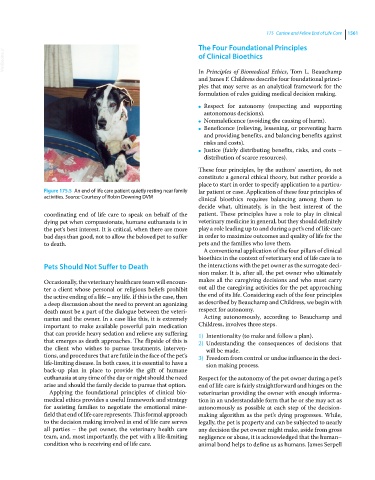Page 1623 - Clinical Small Animal Internal Medicine
P. 1623
175 Canine and Feline End of Life Care 1561
The Four Foundational Principles
VetBooks.ir of Clinical Bioethics
In Principles of Biomedical Ethics, Tom L. Beauchamp
and James F. Childress describe four foundational princi-
ples that may serve as an analytical framework for the
formulation of rules guiding medical decision making.
Respect for autonomy (respecting and supporting
●
autonomous decisions).
Nonmaleficence (avoiding the causing of harm).
●
Beneficence (relieving, lessening, or preventing harm
●
and providing benefits, and balancing benefits against
risks and costs).
Justice (fairly distributing benefits, risks, and costs –
●
distribution of scarce resources).
These four principles, by the authors’ assertion, do not
constitute a general ethical theory, but rather provide a
place to start in order to specify application to a particu-
Figure 175.5 An end of life care patient quietly resting near family lar patient or case. Application of these four principles of
activities. Source: Courtesy of Robin Downing DVM clinical bioethics requires balancing among them to
decide what, ultimately, is in the best interest of the
coordinating end of life care to speak on behalf of the patient. These principles have a role to play in clinical
dying pet when compassionate, humane euthanasia is in veterinary medicine in general, but they should definitely
the pet’s best interest. It is critical, when there are more play a role leading up to and during a pet’s end of life care
bad days than good, not to allow the beloved pet to suffer in order to maximize outcomes and quality of life for the
to death. pets and the families who love them.
A conventional application of the four pillars of clinical
bioethics in the context of veterinary end of life care is to
Pets Should Not Suffer to Death the interactions with the pet owner as the surrogate deci-
sion maker. It is, after all, the pet owner who ultimately
Occasionally, the veterinary healthcare team will encoun- makes all the caregiving decisions and who must carry
ter a client whose personal or religious beliefs prohibit out all the caregiving activities for the pet approaching
the active ending of a life – any life. If this is the case, then the end of its life. Considering each of the four principles
a deep discussion about the need to prevent an agonizing as described by Beauchamp and Childress, we begin with
death must be a part of the dialogue between the veteri- respect for autonomy.
narian and the owner. In a case like this, it is extremely Acting autonomously, according to Beauchamp and
important to make available powerful pain medication Childress, involves three steps.
that can provide heavy sedation and relieve any suffering 1) Intentionality (to make and follow a plan).
that emerges as death approaches. The flipside of this is 2) Understanding the consequences of decisions that
the client who wishes to pursue treatments, interven- will be made.
tions, and procedures that are futile in the face of the pet’s 3) Freedom from control or undue influence in the deci-
life‐limiting disease. In both cases, it is essential to have a sion making process.
back‐up plan in place to provide the gift of humane
euthanasia at any time of the day or night should the need Respect for the autonomy of the pet owner during a pet’s
arise and should the family decide to pursue that option. end of life care is fairly straightforward and hinges on the
Applying the foundational principles of clinical bio- veterinarian providing the owner with enough informa-
medical ethics provides a useful framework and strategy tion in an understandable form that he or she may act as
for assisting families to negotiate the emotional mine- autonomously as possible at each step of the decision‐
field that end of life care represents. This formal approach making algorithm as the pet’s dying progresses. While,
to the decision making involved in end of life care serves legally, the pet is property and can be subjected to nearly
all parties – the pet owner, the veterinary health care any decision the pet owner might make, aside from gross
team, and, most importantly, the pet with a life‐limiting negligence or abuse, it is acknowledged that the human–
condition who is receiving end of life care. animal bond helps to define us as humans. James Serpell

